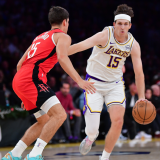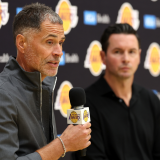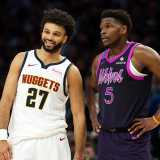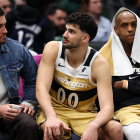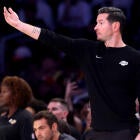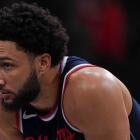2016 NBA Draft Big Board: Kris Dunn brings elite defense, offense to the table
Dunn leads this edition of the Big Board with further notes on some international players as well as Henry Ellenson

Much has been made of the NBA's offensive changes over the last couple of years. Three-pointers are at an all-time high, player height seems to be at an all-time low, and the matter of efficiency is now paramount.
But really, it's on the other side of the ball that the biggest philosophical adjustments have been made. Sure, having a dedicated rim protector is still important. Keeping players out of the middle of the defense is still essential to success. But no longer do you want two big men on the floor to take up space inside. Instead, the idea of downsizing to smaller, more athletic players who can cut off penetration and switch screens with ease has become possibly the biggest adjustment in an era without hand-checking and with less physical play.
Often, these ideas are discussed in regard to the traditional 2 through 4 positions in an increasingly positionally fluid NBA. However, having a primary rim protector defensively and primary ball-handler offensively still matters, which is why the idea of naming positions still has use. Still, the more those positions can be fluid with the rest of the defense, the better the team has potential to be on the defensive end. We saw how successful it can be with Steven Adams at center in the Western Conference Finals this season, and we've seen over the last few NBA Finals games how the Cavaliers have attacked Stephen Curry in pick-and-roll scenarios to get him onto the ball in order to take advantage of him.
In this NBA Draft, there is one particular point guard who should be able to fit directly into what teams want to do defensively now. Providence's Kris Dunn -- currently No. 3 on my Big Board, as seen below -- is that player. Mostly known for his offense, Dunn has the most defensive potential of any point guard to enter the NBA since Marcus Smart. And he knows it.
"I feel like it's because I can play both ends of the floor," Dunn said when I got him over the phone this week. "My greatest strength I believe is my defense. I don't like when people score on me. I take pride in my defense. I have a lot of heart to stop someone."
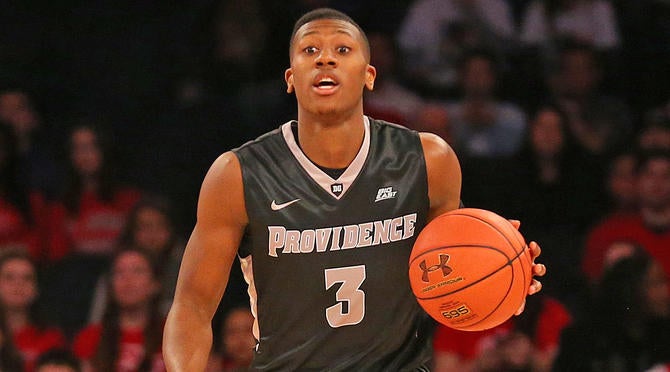
That heart shines through on every defensive possession. He's a bear for opposing guards to deal with due to his 6-foot-4 frame, near 6-foot-10 wingspan and elite quickness. Heck, it's even tough for 2 guards to deal with him because of that. It not only translates to a difficult, pesky player to drive against, but he's particularly successful at forcing turnovers -- possessing the highest steal rate in the draft. Steals translate into points at a higher rate than rebounds or blocks, making them incredibly valuable.
However, maybe the most important aspect to his game is the way he can switch onto bigger players and not be fully taken advantage of. At 205 pounds, Dunn is wiry strong and can use the strength of his lower half and core to at least hold his own on the block. Beyond that, he uses his tenacity and motor to be active with his hands and feet, creating issues for bigger players who think they can back him down in the midrange. Dunn may not have the strength of Smart to be able to legitimately match up with a player like Paul Millsap possession after possession -- as seen in the playoffs -- but his ability will be a legitimate deterrent to bigger players and that's something he relishes.
"I feel like I'm very confident and I'm strong enough to guard 1s, 2s, and sometimes 3s," Dunn said. "I feel like that's coming from the weight room. The coaching staff (at Providence) has done a great job with that."
Sure, the key with Dunn and why he's rated so highly is his ability to provide value offensively with his passing ability and scoring due to his quick first step, terrific vision and ability to finish around the rim. But don't sleep on his defense either. The ability to play competently both ways in today's NBA is as valuable as any elite skill a player may possess, and Dunn has that skill in bunches. Plus, he's a charismatic leader, and has already shown off that persona in commercials for Speed Stick, as seen during the NBA Finals. It should make him quite a bit of money in his career and lead being a top six selection in the 2016 Draft. Without peeping for too many details, I asked Dunn what his plans were with his first paycheck in the NBA, and he gave me a terrific response.
"I'm going to try to buy my brother a nice little house. Nothing too big, nothing too crazy," he explained. "When we were little, I feel like he just carried me. He didn't have that chance to be a kid and have his own, so I'm going to give back to him. And I'm going to make sure my dad is taken care of too. I'm fine. I don't need anything. I just want the opportunity to play in the NBA and make my family proud."
Big Board movement
- International defections have thinned out the board considerably. It now is only 125 names long after all but 13 early entrants withdrew from the draft. The two best players to withdraw: Sasha Vezenkov from Barcelona and Mathias Lessort, who played this season with Chalon but recently signed with JSF Nanterre, both in France.
- Some small movements across the top 30. International players represented by Misko Raznatovic had a workout in New York this past week. Timothe Luwawu shot the lights out, with some scouts believing that it helped to solidify his range in the first round. He moves up my board a bit. Another impressive performer was Ivica Zubac, with one scout noting just the sheer vastness of his size to pair with his ability. "The guy is just huge," the scout said. "He's a legit 7-footer, long as hell. You have to see it in person to really get a feel for just how big he is to pair with the high skill level. It's just different. Sometimes you see players and you just think they look unlike the rest of the pack. Zubac is that player." There are some questions about injuries with Zubac, given that he's fought through some lower body stuff over the course of the last two years. But he pushes into the top 15. It's not often that you hear teams speak in such glowing terms.
- Henry Ellenson pushes down the board a bit to No. 17. Simply put, NBA teams aren't sold that he's going to guard anyone in the NBA. He might be stuck between a rock and a hard place, and Kevin Love's performance in this year's playoffs likely isn't helping matters in that regard. Not a strong enough rim protector to play as a true 5 without a rare shot-blocking 4, not quite mobile enough to play at the 4, the concerns are real. Plus, his jumper really is starting to worry teams. While it looks gorgeous and should be translatable, he's never hit outside shots at a high percentage and teams have started to wonder what his role is if he can't consistently hit that shot. I think his range is now more No. 10 to 20 than the guaranteed top-10 talent that many thought he was entering the process.
- Paul Zipser moves up the board to No. 23. Simply put, I've always been high on him and think he is a genuine first round talent. Then last weekend, he got to show that off in front of NBA teams where he won the MVP award of Adidas Eurocamp. He's not going to become an elite NBA player. But he hits shot at an extremely high clip, defends multiple positions at 6-foot-8, and is a legitimate NBA athlete. As a 3/4 combo forward, there's not much more you can ask for in the modern NBA, even if he struggles to create his own shot a bit.
- It was a bit of a surprise to find out that Georgios Papagiannis was keeping his name in the NBA Draft this season as a first-time eligible international. However, he had a strong workout in Philadelphia at Temple University, and could be in play for teams at the end of the first round. Particularly, teams that are looking to stash a prospect may look kindly on Papagiannis, as the 7-foot-2 center has a pretty good situation at Panathinaikos and likely is amenable to staying over there for a couple more seasons to improve his game. He's at No. 39 on the board.



